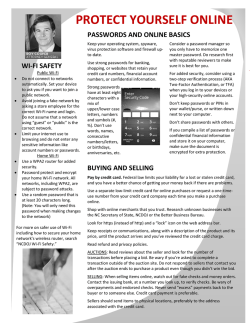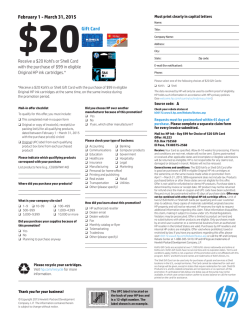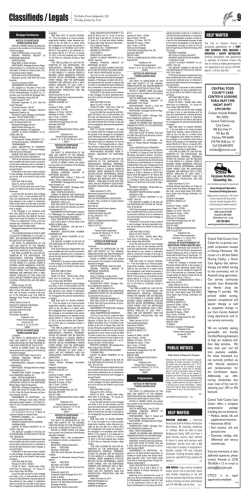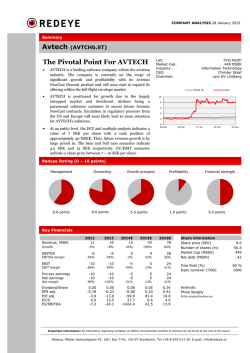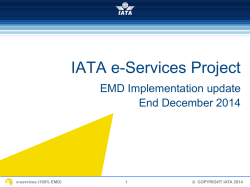
4 PR Banks Said Tough Enough to Weather Storms in 2015
16 The San Juan Daily Star Monday, December 29, 2014 4 PR Banks Said Tough Enough to Weather Storms in 2015 By EVA LLORENS VELEZ [email protected] A research and financial services firm from New York says four of Puerto Rico’s banks are expected to survive 2015 even though the island’s economy is expected to continue facing challenges. A new report from Keefe, Bruyette & Woods evaluated local banks and their exposure to financially ailing public corporations. “We found that, although the environment remains challenging, we believe the banks’ balance sheets are strong,” said the report, titled “Strong Banks in a Weak Environment.” The report examined Banco Popular, FirstBank, OFG and Scotiabank and found stronger balance sheets and smaller, more stable banks despite the island’s economic difficulties. “In our meetings with bank managers and government officials we came away with a sense that there is a will in both the private and public sectors to address the problems facing Puerto Rico. Not all of the individuals we met agree with all the proposed or implemented changes, but there was definitely active dialogue,” analysts Brian Klock and Glen Manna said. “That said, the economic problems were neither created, nor will they be solved, overnight.” The report calls for a reform of the island’s public corporations, tax system, and teachers’ pension system, tagging all as remaining issues either in progress or not yet addressed. The government expects to approve tax reform by March and have a business plan for the Puerto Rico Electric Power Authority (PREPA) in March. But the report still predicted a 1 percent to 2 percent annual decline in gross national product (GNP) and continued sluggish growth in employment. Banks can expect flat trends in commercial loan growth, wholly offset by a contraction in consumer loan growth, and a moderate deterioration in consumer credit, the analysts said. But management teams and government officials are optimistic that the decline in oil and gas prices could have a meaningful positive impact if they stay lower for longer. The government already expects low gas prices in January and February. “Compared to the fiscal and economic conditions in Puerto Rico last year, we believe conditions, while still challenging, have marginally improved,” the analysts said. The report noted that the unemployment rate has shown staggered improvement, but the labor force is shrinking. Recently, there was an increase in jobs in the private sector. In October 2014, there were 160,500 workers unemployed in Puerto Rico, representing 14 percent of the total labor force of 1.14 million workers. This is actually an improvement from October 2013, when there were 177,300 unemployed and the unemployment rate was 14.9 percent. However, the year-ago period was based on 1.19 million workers in the labor force, the report says. The Keefe, Bruyette & Woods report noted that public corporations will be on center stage in focus for 2015, adding that issues related to PREPA restructuring and the Highways and Transportation Authority’s fiscal independence could be negatives for the economy. Public corporations are slated to pay high amounts in debts in 2015, including $650 million by PREPA, which is undergoing a restructuring. After meeting with the banks in the $550 million syndicate, Keefe, Bruyette & Woods continues to believe the banks’ risk of loss should be significantly less than those of bondholders. American Airlines Says ‘Strong’ Profit To Allow Bigger Wage Hikes A merican Airlines said Tuesday that it plans to pay flight attendants an additional four percentage points on top of raises already averaging 10 percent, thanks to profits that have strengthened as oil prices have collapsed. In a letter to employees, Chief Executive Officer Doug Parker said “very strong” results for 2014 would allow the carrier to lock in substantial wage hikes for the flight attendants. Other work groups would also see improvements in their raises—once their respective contracts are ratified. Plummeting oil prices have slashed costs at the world’s largest airline by passenger traffic, which is poised to save more than its competitors because it did not hedge against prices rising. Unions have called on Parker to tie employee compensation to the company’s performance, but Parker has opposed profit-sharing, practiced by Delta Air Lines, United Airlines and Southwest Airlines. “There are many ways to share success, but when it comes to compensation, we believe it is best to reward (workers) with industry leading wage rates not lower wages supplemented by compensation that varies with airline profitability,” he wrote in the letter, obtained by Reuters. The pay increases show how seriously American views labor relations, which have often emerged as a stumbling block in other airline merger deals, as it joins its operations with US Airways a year into the carriers’ merger. Hourly rates for flight attendants will be seven percent higher than those at Delta or United, Parker said in the letter. A separate letter from the airline cited an hourly rate of $24.18 for first-year flight attendants. Yet the announcement also placed American’s other workers under pressure to conclude contracts, a prerequisite for their raises. The carrier hopes to avoid the fate of other merged airlines that struggled for years to reach deals for all their workers. Pilots are the next group up for a contract, and the company said in a third letter Tuesday that it had ended negotiations with them, leaving them to choose between a final offer or arbitration as early as February 2015. The letter added that if pilots accept the offer prior to Jan. 3, higher pay rates would be effective retroactively as of Dec. 2, 2014, rather than after the agreement. The company’s proposal would raise pilots’ pay about 23 percent upon signing and then three percent for the next two years, compared to smaller gains they would get under an arbitrated contract, the company said in the letter. The airline has also proposed various changes to work rules, some of which have been sticking points in the negotiations. The Allied Pilots Association, which represents American’s pilots, said its board will convene on Jan. 2 and 3 to decide a course of action. The San Juan Daily Star Monday, December 29, 2014 17 Selling the Family Home Is Liberating for Many Retirees Mike and Barbara West are selling the home in Bethesda, Md., that they have lived in for 26 years, and building a new home in Florida By HARRIET EDLESON W HEN is a house your safe haven and when is it standing in the way of richer life experiences? That’s the question more and more retirees are asking these days. Take Barbara and Mike West and Joseph and Phyllis Applebaum, retirees and longtime Maryland residents. After years of analyzing their financial situation, the Wests decided to put the mortgage-free suburban house they had owned for 26 years on the market. They wanted to avoid the mid-Atlantic winters and considered moving to Hawaii, where they had lived while Mr. West was in the U.S. Navy. But they decided it was too remote. They also ruled out San Diego, Savannah, Ga., and Charleston, S.C. Florida, they decided, was a possibility. They considered renting their Maryland house out for part of the year, yet the idea of storing some of their household goods and someone else sleeping in their bed changed their minds. Of the decision to sell a mortgage-free home, Barbara West, 63, said it would give them a chance to dream and to explore. Besides, “It’s a lot of money locked up in the house,” said Ms. West, who retired from her job as a lobbyist two years ago. “It’s a nice side benefit. It will free up money. We’ll have more flexibility. We’re kind of looking at it as an adventure.” The Applebaums — Joseph, 71, and Phyllis, 67, also decided to buy a place in Florida. Their calculations were slightly different. They still had a mortgage on their home, where they had lived for 27 years. By selling the house, they could take the profit, buy in Boca Raton for cash and be mortgagefree. For those 65 and older who have paid off their mortgage — approximately 70 percent of homeowners in that age group — the financial future looks bright. Many still want to sell their homes to free up money that would give them more flexibility during retirement. So they sell or plan to sell their home, and create a less expensive lifestyle. For those who have a mortgage, selling and moving to a less expensive area can create a mortgage-free lifestyle. Close to 80 percent of the 41 million Americans age 65 and older are considered homeowners — whether or not they carry mortgage balances. That is the highest percentage of all age groups, according to the Consumer Financial Protection Bureau. While the overall homeownership rate has remained the same during the last decade and even after the recession for the 65 and older demographic, the percent of older owners with a mortgage increased to 30 percent in 2011, from 22 percent a decade earlier, according to a May 2014 C.F.P.B. report. For those age 75 and older, the percentage carrying mortgage debt more than doubled, to 21.2 percent from 8.4 percent, in the same period. Reasons include the refinancing boom of the 2000s, a first-home purchase later in life, smaller down payments and the use of home equity lines of credit, the report said. For 2013, the percentage of homeowners age 65 and older carrying mortgage debt remained at 30 percent, according to the C.F.P.B., which releases the data every two years. “There is a definite trend that older Americans are carrying debt into their retirement years,” said Stacy Canan, deputy assistant director for the C.F.P.B.’s Office for Older Americans. “Decades ago it was sort of rare.” She does not see that trend abating as the age groups younger than 65 are carrying mortgages, too. Older Americans have credit card debt and student loan debt, but the “largest part of the debt, without a doubt, is related to their mortgages,” Ms. Canan said. After more than one trip to Florida, the Wests found through friends a community under development near Jacksonville, and decided to build a four-bedroom house there. “New has a lot of appeal, especially at our age,” Ms. West said. For Mike West, 65, who retired in June, the house in Florida would be the closest he would come to building his dream home. Rather than cut and trim the lawn and shrubbery as they have been doing in Maryland, they will pay for services and travel more. Changing their lives won’t happen overnight. From the time they signed the papers, it was going to take 10 months for the house to be built, so they expect it to be ready in July 2015. The biggest gain is the sense of freedom that lies ahead. “We’re hoping our house sells early so we’ll be homeless for a few months,” Ms. West said. The calculations in trading one home for another are individual and depend on the value of the house, the equity in it, income, anticipated future income and other expenses. Those in the throes of change typically spend time analyzing the kind of life they want, how much income they will have and their costs. With home and home-related expenses the largest cost for every age group 50 and older, according to research from the Employee Benefit Research Institute, it’s worth considering if you will be able to afford the cost of living where you are, whether you want to stay there and what your other options are. “They need to sit down and figure out their retirement plan — what’s coming in and what’s going out,” Ms. Canan said. The E.B.R.I. report, based on research from 2007 through 2011, shows declines in spending on housing costs, but whether the spending patterns will continue remains to be seen. “The crash had really changed some spending patterns,” Sudipto Banerjee, a research associate with E.B.R.I, said. Even those with considerable investment portfolios are aware of the uncertainties in the financial markets. “They say, ‘I don’t know now how the return will be. The bottom line is I need to save more.’ That’s why we’re seeing these big spending cuts,” Mr. Banerjee said. According to a study from the Society of Actuaries, Personal Risk Management: 2013 Risks and Process of Retirement Survey Report, cutting back on spending or intending to “is not as income-sensitive as might intuitively be imagined.” Among retirees with annual incomes below $50,000, 79 percent had already cut back on spending or planned to, while 73 percent of those with incomes greater than $100,000 were spending less as well. Freeing up money from a house or other property that no longer meets your wants and needs is often the first step. “If you can be retired and not have a mortgage, it can be a lot better,” said Anna Rappaport, chair of the Society of Actuaries’ Committee on Post Retirement Needs and Risks. Adventure appealed to JanSuzanne Krasner and her husband, who had paid off their mortgage. Two years ago, they sold their house in Westchester County, N.Y., and left for Israel on the last flight out the night of Hurricane Sandy. They rented an apartment in Tel Aviv for 10 months. Next, they spent a month traveling in southern Africa and Europe, then rented an apartment in Manhattan for two months. They had sold most of their belongings except personal memorabilia, and decided to buy a furnished place in Boynton Beach, Fla., for cash. “By moving to a less expensive area, it frees up money to travel,” said Ms. Krasner, 67, who had been in business with her husband for many years, retiring in 2009. “We have enough money to feel secure.” For both the Krasners and the Wests, maintaining family ties were a priority and played a role in their decisions. Each of the couples has two grown daughters whom they want to be able to see. Mrs. West has a sister in Florida, and the Krasners have a number of cousins in the state. Family relationships, the weather and the cost of living were paramount. “The rest didn’t matter,” Ms. Krasner said. “Nothing will be perfect. We prioritized.” They hope to spend three months of the year in Tel Aviv. 18 The San Juan Daily Star Monday, December 29, 2014 Even for the Person Who Has Everything, Gifts Matter By PAUL SULLIVAN R . COURI HAY, a society figure in Manhattan, is not one to think small when it comes to holiday presents. He gave a former partner two Andy Warhol prints of Marilyn Monroe, because by that point in their relationship he had given him every other Monroe-inspired item he could think of, from kitschy items to trips to places linked to her. He once presented Cornelia Guest, a socialite and animal rights activist, with a plate of jewels. He told her she could pick whichever one she wanted but that only one of them was real. (“I knew the real one,” Ms. Guest said. “That was a fun present.”) For his mother, he went so far as to commission Peter Max, the pop artist, to create a painting from a photo of his mother and grandmother. “It brought tears to her eyes,” he said. “She was genuinely surprised to receive that.” And it is that surprise that he says he and his friends try to give each other above all else. “My friends and my family and my partner — they’re all really spoiled,” he said. “They can all basically buy anything they want for themselves.” But this year, Mr. Hay thinks he has really outdone himself. For his current partner, he has the gift of all gifts— better than the Damien Hirst painting he gave him last year, better even than the Range Rover with a bow on top. Spoiler alert: He’s getting a threefoot-tall Fabergé egg painted with koi fish. Why this? His partner loves koi and tends to the ones in the garden in their townhouse. The egg, which he has been hiding for months, was painted by the artist April Gornik, and Mr. Hay bought it at a charity auction. “When I saw it painted with koi fish, light bulbs went off and it was like, ‘Let it snow, let it snow, let it snow,’ ” Mr. Hay said. “I’m putting a big box over it. I think he’s going to go into shock. I believe he will not guess what is inside the box.” Of course, one man’s perfect surprise is another’s ho-hum gift — or frivolous indulgence. If you’re not a small child, does any of this gift-giving really matter? Should we even bother spending money on gifts that are extravagant, thoughtful or both for our friends? Yes, it turns out, we should. Gifts matter. Elizabeth W. Dunn, associate professor of psychology at University of British Co- lumbia and a co-author of “Happy Money: The Science of Smarter Spending,” (Simon & Schuster, 2013), pointed to a study she was involved in that tested couples’ reactions to the gifts they thought their partner had selected for them. “We lied and told them their partner either picked their top choice gift or their second-to-last-favorite gift,” she said. “People freaked out. One time I had to dive between a couple who was saying, ‘Why would you get that for me?’ ” Of the 10 gifts they chose from, all were less than $10. In the experiment, what gift people picked for their partners ended up influencing how they responded when asked if they would marry the person. “What that says to me is that people should put some thought and money into a gift,” Ms. Dunn said. But she said extremely expensive items might also be about a giver’s inability to pick an appropriate gift. “People aren’t good at giving gifts,” she said “Most people solve that problem by thinking what they themselves would like. That’s fine when you’re similar to the gift recipient, but sometimes people are just trying to throw money at the problem.” Scott Diament, president of the Palm Beach Show Group, which produces art, antiques and jewelry shows, is giving a $295,000 Christophe Claret Margot watch to his girlfriend this year. “When you care about someone who is really special to you, you want to find something that says something about you, about them, about the relationship,” he said. The watch struck him as a significant display of affection — only 20 were made — but also appropriate for his girlfriend since the design is about love itself. “You can click a button and it comes up ‘he loves me, he loves me not,’ ” he said. “You can also set it so it always comes up ‘he loves me.’ ” The proverbial Grinch with such lavish presents is the gift tax. Michael Malakoff, managing director of wealth planning at Ascent Private Capital Management in San Francisco, said few people thought they needed to file a gift tax form for a holiday present. If the gift is worth more than $14,000 and is going to anyone other than a spouse, they do — even if no tax will be owed. “If you don’t, you’re playing the audit lottery,” he said. This is a risk many are willing to take, since the gift tax is not as closely audited as the estate tax, he said. Other research shows that while gifts are important, these high-value baubles may not be the best way to deepen a relationship. Experiences would be better. And they don’t have to be extravagant ones. A gift certificate to a favorite restaurant will suffice. Cassie Mogilner Holmes, assistant professor of marketing at the Wharton School at the University of Pennsylvania, in a coming paper looked at how gift-giving fostered relationships. All gifts helped to strengthen relationship bonds, but those that were experiences made those bonds even stronger. “If my best friend were to take me out to dinner or give me a gift certificate to that same restaurant, my receipt of that gift would lead me to feel closer to her than if she had given me a sweater,” Ms. Holmes said. “People are more likely to give material gifts because they have this notion that come Christmas morning you want to have something under the tree to unwrap. There is this assumption that they’ll think of you whenever they use it.” But this assumption, her work suggests, is false, and people would be better off giving concert tickets or signing someone up for a wine club. “When you’re consuming an experience you feel a greater intensity of emotion than when you’re consuming a material good,” she said. In other words, the sweater — or $295,000 watch or Fabergé egg — is great when you unwrap it, but over time you get used to it in a way you don’t with the memory of a great night out. Sheila Rosenblum, owner of Lady Sheila Stable, a horse-racing syndicate, said she gave her 80-year-old uncle a racehorse this year, to fulfill his dream of owning a thoroughbred. But when it came to her two children she went for an experience, an extreme-sports vacation that will include tandem paragliding, ziplining and, of course, horseback riding, from Dubai to New Zealand. The risk is that the giver picks an experience that the giver would like, not one that the receiver wants. But that can happen with any gift. And even at this level of gift-giving, there is no guarantee that the gift will get used, no matter how lavish or thoughtful. Martin D. Shafiroff, an investment banker, commissioned the artist Iké Udé to create a portrait of his wife, Jean, in 2012. “I wanted it done before I got too old,” Mrs. Shafiroff said of the stylized picture. Alas, while she says she loves it, the picture is not hanging on the Shafiroffs’ walls. “We have other types of art in the home,” she said. “We’ll eventually hang it somewhere. But it’s here in my home, and I’m very happy that I have it.” While reveling in giving gifts, Mr. Hay, whose home is filled with gifts from a lifetime of being on the Manhattan social scene, does not subscribe to the adage that it is better to give than receive. “I never tell people ‘No gifts,’ ” he said. “Who doesn’t like to unwrap a gift? I’m difficult to buy for and surprise. But you can shop for me. I don’t want to discourage anyone.” And if all else fails, he said, there are always chocolates. The San Juan Daily Star Monday. December 29, 2014 19 Cramped in Coach, but With Better Entertainment A IR travel, as an experience, sure leaves a lot to be desired. Smaller seats, higher baggage fees and ticket prices (despite lower fuel costs) are just a few of the myriad complaints. On the bright side, however, airlines are making more money, and after years of outdated in-flight entertainment, investments in onboard technology may entertain passengers enough to make the miles go by more quickly. Most United States carriers have, in recent months, announced updates and improvements to their domestic in-flight tech that, in some cases, even provide free entertainment to the poor souls back in coach. These new services let you use your own mobile devices, like tablets, laptops and phones, to either stream free content like TV, music or games, or to rent movies and TV without having to pay for a Wi-Fi plan. At the center of many new offerings is Gogo Air, the in-flight Internet pioneer that provides both Wi-Fi on planes and more full-fledged entertainment options. Delta Air Lines’ new Delta Studio service, for example, relies on Gogo. The service, released in August, is available to all passengers on any flight over 90 minutes, letting them stream satellite TV, music and video games on a personal device without paying for a Wi-Fi plan. When you open a browser window on your laptop, tablet or phone, you’ll see a menu that offers movies and TV to stream or rent. What you see is based on where you’re sitting. (You’ll be asked for your name and seat number when you sign in.) So-called premium movies and TV are free for first, business and upgraded economy class, but Delta said coach passengers get at least something free, and can pay $6 for additional movies and $1 for TV shows. If you want to surf the web or check email, though, you’ll still have to pay for Wi-Fi. And be aware that to get the free streamed content, you must download Gogo’s video player app before boarding the flight. Alaska Airlines this week announced a similar service, also powered by Gogo, that will let fliers rent movies and TV even if a separate Wi-Fi subscription isn’t available on the flight. JetBlue, which has long been popular thanks to its satellite TV in flight — every plane in its fleet has a seat-back TV — is also leaning heavily on personal devices Virgin America is the cream of the crop when it comes to high-tech in-flight entertainment, says tech columnist Molly Wood. Travelers can have wifi and free satellite television, all from their seat. and faster Wi-Fi. The airline’s Fly-Fi service uses satellite-based Internet access, instead of the more typical ground-to-air system, with speeds that can rival home broadband networks. The airline is still deploying the faster Wi-Fi throughout its fleet; it said just under half its planes offer the faster Internet options. A JetBlue spokeswoman said the rollout would be complete in spring 2015. If you’re on a flight with Fly-Fi, you can get basic web access free, or upgrade to even faster Internet access for $9 an hour. Those prices may change after the entire fleet has the technology. That’s expensive, but I’ve paid as much or more for Gogo’s in-flight Wi-Fi and had it work at a crawling pace. If you really wanted to stream a movie from Netflix, the cost might be worth it. Its free content includes programs from Fox and National Geographic, e-learning videos, book excerpts and cooking shows. Personally, I’d rather watch the live TV on the seat back, but maybe a Fox series would suffice if the TV signal became choppy. Many airlines are finding that offering better in-flight Wi-Fi and a few free content options is easier and cheaper than upgrading expensive seats to include seatback TVs. And a few free offerings go a long way, especially in coach. “Other than pouring us endless martinis, that’s just about the only thing they can do to keep us happy in flight,” said Jack Plunkett, chief executive of Plunkett Research, a market research firm based in Houston. Mr. Plunkett said airlines were slow to jump into in-flight technology after the industry’s first major attempt — the seatback telephone — proved a “dismal failure.” “It added a lot of weight to the airplane, drew a lot of power and required a communications system connecting the airplane to a comm system on the ground,” he said. “After that failure, it was hard to talk them into trying Wi-Fi on board.” But as personal devices like phones, tablets and laptops became more and more common, and third-party Wi-Fi providers offered to shoulder the cost of in-flight Internet access, airlines realized that the “bring your own device” model of in-flight entertainment could be cheap and easy. And instead of replacing entire seats to add entertainment, airlines are adding welcome niceties like power outlets and USB plugs in every row. So, using in-flight Wi-Fi to stream a movie to a plugged-in tablet becomes a better way to fly. Southwest Airlines, always bare bones in terms of its actual planes, offers WiFi on about 80 percent of its flights. While the company said its smaller aircraft would not be retrofitted for Wi-Fi, any new jets that come into the fleet will have it. Southwest also includes live Dish satellite TV and Beats Music playlists wi- thout requiring passengers to pay for a Wi-Fi plan, and said it was the only airline that offered wireless Internet access during taxiing, before takeoff and after landing. In the coming years, expect in-flight Wi-Fi to continue to get faster — and hopefully cheaper. Virgin America announced this week that it had upgraded its in-flight Wi-Fi, provided by Gogo Inflight, to up to 10 megabits per second, close to a typical home broadband connection. The connections in-flight will probably be slower, because everyone is sharing the Wi-Fi, but that is still an improvement. And Gogo said that it was testing satellite-based Wi-Fi, instead of the current ground-to-air system, and that could provide a plane with a connection of 70 megabits per second. Even shared among passengers on a plane, that would be speedy Internet. A few carriers are, of course, slower to upgrade than others. United, for example, offers Wi-Fi access on only about half of its jets, although it just announced plans to bring Wi-Fi and Gogo-powered personal device streaming to some of its smaller United Express planes starting early next year. About 200 of its 700 planes offer seatback entertainment. American Airlines offers Wi-Fi on all its big jets, but only on 12 percent of its regional planes, and it has some kind of seat-back entertainment in 58 percent of its wide-body jets, the company said. And then there’s the domestic inflight dream: Virgin America, often lauded as having the best domestic in-flight system of them all. Yes, every flight has (newly upgraded) Wi-Fi, power outlets and USB ports. But every plane also has seat-back TVs that stream live television and offer on-demand movies and TV (free to Main Cabin Select and first-class passengers). The TVs serve as touch-screen ordering systems for food and drinks, which are then delivered directly to your seat. You can use them to play games and chat with other passengers, and Virgin America just introduced a new feature that lets you send a drink to another passenger on the plane. Such seat-back amenities might not be practical to maintain forever, especially as personal devices and faster in-flight Internet access become cheaper and easier to deploy. But for now, the best of all worlds is still the best option.
© Copyright 2026
